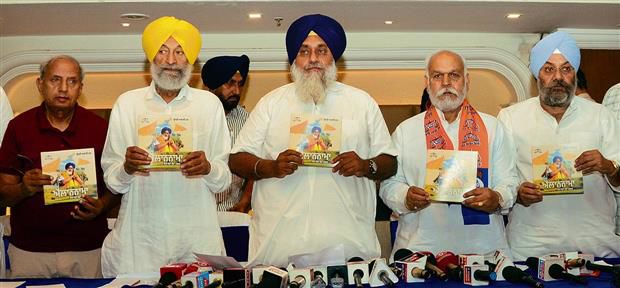
The Shiromani Akali Dal (SAD) made an unexpected political statement by including the transfer of the sacred Kartarpur Sahib from Pakistan to India in its election campaign. This admiral scheme proposes trading land between the two nations as a diplomatic solution. Sukhbir Singh Badal, the SAD’s leader, has pledged to make efforts to integrate Punjab with Chandigarh and the neighboring Punjabi-speaking districts. The manifesto advocates for a licensing system that does not require pilgrims to hold passports to facilitate easier entry to this significant Sikh monument. SAD demonstrates its well-planned approach to the upcoming elections by playing on religious and regional sentiments.
A portion of Indian Punjab’s story is its small size and scarcity of resources. It follows the story of a brave people who, against every challenge, persevere in their fight for freedom and justice. The reorganization in 1966 reduced the area from 202,000 square kilometers to a mere 50,362 square kilometers. The Punjabi people feel they have lost something due to the central government’s cuts. Despite these obstacles, Punjab is an important agricultural area in India, contributing significantly to the country’s food security. The fight for justice and freedom deeply connects the state’s cultural fabric.
The Punjab Reorganization Act of 1966 resulted in Haryana and Himachal Pradesh acquiring eleven districts that had previously been part of Punjab. Because of the linguistic division, the majority of Punjabis now live in a small state that was once home to Hindi speakers. Le Corbusier’s design, Chandigarh, became a federally managed Union Territory upon its abandonment, marking the worst catastrophe. This conduct not only diminished the political capital of Punjab but also diminished its relevance. “The division… was more than just a change in territory; it was a blow to the heart of Punjabi identity,” said expert Gopal Krishan. In Chandigarh, the state’s assertions of entitlement to compensation and authority are contentious. It stands for the struggle for the independence of the Indian government’s struggle for independence.
Population dispersion and the depletion of agricultural and economic resources have fractured Punjabi culture. Because of land divisions, Punjab now has fewer rich fields that are used to feed the country. The ongoing water conflict with neighboring Haryana makes the burden of territorial shrinkage even worse. The rivers Ravi and Beas, vital to Punjab’s agricultural economy, are believed to have ancient rights. For fear of further depletion of its water supplies, the Sikh community has fiercely opposed the construction of the Sutlej-Yamuna Link (SYL) Canal.
The Sikh community is highly esteemed in Pakistan for its reputation for bravery, honesty, and humility. Their cultural and historical practices have long ingrained these traits. Pakistanis hold Sikhs in high regard because of their reputation for integrity, courage, and reliability. Strategically, many in Pakistan believe that a sovereign Sikh country would be beneficial, as they anticipate a cordial border that would facilitate commerce and collaboration. The Kartarpur Corridor, a symbol of connectivity that allows Sikh pilgrims to visit the Gurdwara Darbar Sahib in Kartarpur without a visa, is a prime illustration of this thinking. This initiative has received public appreciation as evidence that Pakistan values Sikhs, and this initiative has garnered appreciation from the public.
The World Bank estimates that $37 billion is the potential value of commerce between Pakistan and India. As a result, welcoming borders opens up numerous possibilities. According to academic Ian Talbot, the tunnel represents “a rare moment of cooperation… a bridge between two divided Punjabs.”
As an example of Pakistan’s dedication to religious tolerance and interfaith cooperation, the Baba Guru Nanak Darbar shrine has grown from a little 5 acres to a vast 975 acres. With this massive project, Pakistan is demonstrating its will to promote unity and peace by providing a place for an increasing number of Sikh pilgrims. By removing bureaucratic hurdles for Sikhs to visit this holy site—the visa-free Kartarpur Corridor project—Pakistan continues to show its commitment to preserving a healthy relationship with the Sikh community. This gesture symbolizes the extension of faith and trust between countries and religions, as well as the growth of the territory.
The linguistic base division within India, the focus of this piece, has separated trouble spots, particularly those significant to Sikhs. Like the way people in Europe get along with each other so well that borders do not matter much, the primary objective of making Guru Nanak’s country a safe place for Sikhs goes beyond these differences. People can work together and find peace through the Kartarpur Corridor. This relationship could honor Guru Nanak’s heritage and enhance economic growth, just as the single market in the European Union has raised GDP by 15% since 1992. A mutually beneficial relationship between Pakistan and the Sikhs could model peace and growth in the region by overcoming language barriers.
